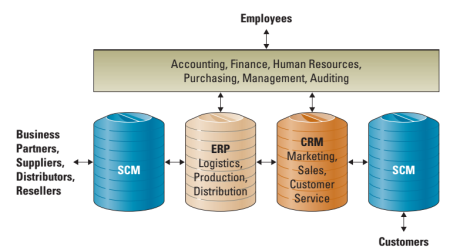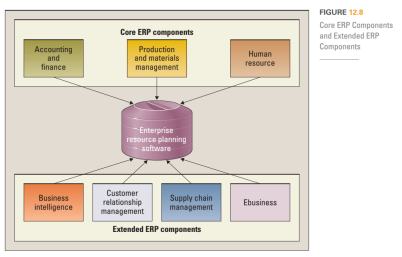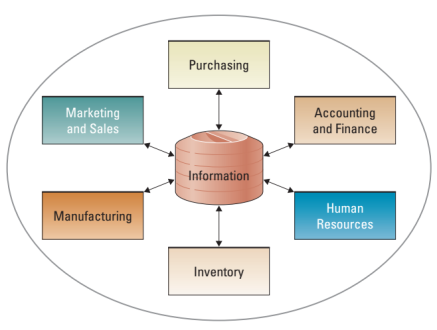PDF File: Ernesto Mancia -Case Study 2 – Enterprise Information Management Systems
Problem Statement
The goal of any Enterprise Information Management System (EIMS) software package should be to efficiently, dependably and securely manage all the information required for an organization’s day-to-day operations and decision making processes. A robust EIMS package should, at minimum, integrate the following three core enterprise management functions: Enterprise Resource Planning (ERP), Customer Relationship management (CRM), and Supply Chain Management (SCM) (Figure 1).
Figure 1: Integration between ERP, CRM and SCM applications

Figure 1. Baltzan, P. (2015). Business Driven Technology. New York, NY: McGraw-Hill Education.
Robust on-premise EIMS software packages were previously only accessible to corporations with adequate investment capital, but the introduction of cost-effective cloud computing technology has made cloud based iterations of such systems accessible to small and medium sized organizations. The new cloud technology offers cheaper, simpler and often wider alternatives when compared to legacy on-premise models of enterprise computing (Heisterberg & Verma, 2014). However, cloud based EIMS services have also introduced additional compliance, network and security concerns that must be addressed during the evaluation, selection and implementation process.
Challenges & Opportunities
Although a large number of companies will rely on cloud-based EIMS services by the year 2020, the failure rate of implementing just the core ERP is high; ranging between 67% to 90% (Gupta & Misra, 2016). Since a ERP system is a key component of any EIMS package, this statistic should not be overlooked. The ERP system provides fundamental decision-making support and enables collaboration between an organization’s internal operations (Figure 2).
Figure 2: Core ERP Components and Extended ERP Components

Figure 2. Baltzan, P. (2015). Business Driven Technology. New York, NY: McGraw-Hill Education.
According to Gupta & Misra, vendor selection is critical to a successful implantation of a cloud-based EIMS software package. The organization should select a vendor that has the capability to customize the software package based on the organization’s current and future business needs. Additionally, given that implementation of a EIMS solution is a significant undertaking for organizations of all sizes, the number of vendors should be kept to a minimum. Organizations evaluating software packages should first turn to vendors that provide the complete suite of solutions instead of cherry-picking EIMS components from multiple vendors. Sticking to a single vendor will help reduce the implementation costs associated with API and middleware development. Additionally, dealing with a single vendor could mitigate cloud-based network and security concerns related to downtime, data archiving, segregation of duties, network latency, confidentiality of data, encryption and maintenance (Gupta & Misra, 2016).
Business Solutions
As stated earlier, the core ERP application is what helps EIMS package and organization work towards operational efficiencies, lower costs, improved supplier and customer relationships, and increased revenue (Baltzan, 2015). It achieves this by leveraging a central database that collects and distributes information throughout the various departments within the organization (Figure 3). This is why it’s important that any potential software vendor be well versed in what is needed to deploy and maintain a robust ERP solution. Vendors such as NetSuite, Oracle and SAP are not only leaders within the ERP space, but they all provide the additional components (CRM and SCM) to build a well integrated out of the box EIMS solution.
Figure 3: ERP Integration Data Flow

Figure 3. Baltzan, P. (2015). Business Driven Technology. New York, NY: McGraw-Hill Education.
EIMS Application Packages
Out of these three vendors, NetSuite is the only one to have been built from the ground up to be a cloud computing software company. It’s ERP solution has built-in SCM tools and offers a separate CRM product which is as robust as Salesforce’s offering (Netsuite: Enterprise Resource Management, n.d.). NetSuite’s ERP system is recommended for small to medium sized organization.
On the other hand, Oracle built its legacy on a robust on-premise EIMS solutions, but recently has made the jump to the cloud by launching Oracle Cloud, which offers ERP, CRM and SCM through its software as a service (SaaS) applications. Oracle also touts its SCM application as the most comprehensive SCM suite in the cloud (Oracle Cloud: Reimagine Our Business, n.d.). A point that shouldn’t be overlooked given that a SCM ultimately helps maximize profits by optimizing the price of raw materials, sub-products, final products, and maintaining sufficient stock levels (DZIEŻA, SIKORA & NOWAK, 2016).
Finally, SAP offers their cloud-based ERP called, SAP Business ByDesign. Like Oracle’s offering, SAP’s ERP solution is built on SaaS applications that provide ERP, CRM and SCM capabilities. But like NetSuite, SAP’s solution is recommended for small to medium sized organizations (SAP Business ByDesign: Cloud-based ERP for Mid-market Companies and Subsidiaries, n.d.).
Lessons Learned
Which EIMS solution should ultimately be selected? It depends on the organization’s key business functions. A large retailer might find what it needs in Oracle’s cloud solution because of its scalability and strong SCM application. On the other hand, a small sales organization might get more out of NetSuite’s solution because of its focus on small to mid-sized organizations in addition to its robust CRM product. Ultimately, what is most important is that organizations focus on minimizing the costs and potential risks associated with undertaking the task of implementing a EIMS software package. This can be achieved by going cloud-based; there by eliminating the upfront and ongoing investment required to manage and maintain on-premise software and hardware. Organizations should also look to a single tried and true leader in the EIMS/ERP space (such as Oracle, NetSuite and SAP) that provide integrated cloud-based EIMS solutions. Finally, once software costs have been negotiated, organizations should work closely with the selected vendor in order to build a trust-worthy relationship and to mitigate any compliance, network and security concerns.
Why I Care
Given that most of the EIMS solutions available in the market place are capable systems, I need to be able to look past the noise and focus on the key attributes that will create value and synergies between the organization and the cloud-based service provider. Additionally, as more and more companies begin to rely on cloud-based EIMS solutions to gain the competitive edge, I need to understand both the benefits and risks associated with the implantation of a cloud-based EIMS software package.
References
Baltzan, P. (2015). Business Driven Technology. New York, NY: McGraw-Hill Education.
DZIEŻA, G., SIKORA, M., & NOWAK, A. (2016). THE IMPLEMENTATION OF THE ENTERPRISE RESOURCE PLANNING SYSTEM AND ITS INFLUENCE ON LOGISTICS. Studia I Materialy Polskiego Stowarzyszenia Zarzadzania Wiedza / Studies & Proceedings Polish Association For Knowledge Management, (82), 38-48.
Gupta, S., & Misra, S. C. (2016). Compliance, network, security and the people related factors in cloud ERP implementation. International Journal Of Communication Systems, 29(8), 1395-1419. doi:10.1002/dac.3107
Heisterberg, R., Verma, A., (2014). Creating Business Agility. Hoboken, NJ: John Wiley & Sons, Inc.
Netsuite: Enterprise Resource Management. NetSuite, n.d. Web. 10 July 2017. .
Oracle Cloud: Reimagine Our Business. Oracle, n.d. Web. 10 July 2017. .
SAP Business ByDesign: Cloud-based ERP for Mid-market Companies and Subsidiaries. SAP, n.d. Web. 10 July 2017. .